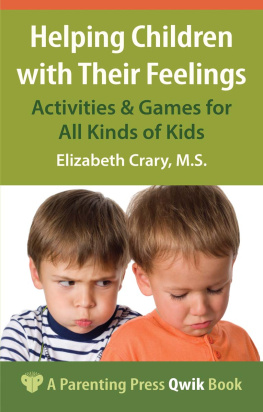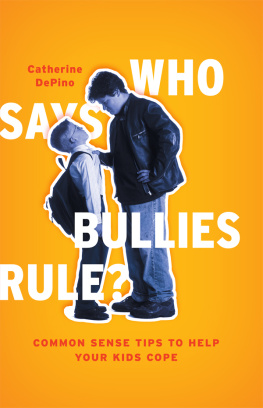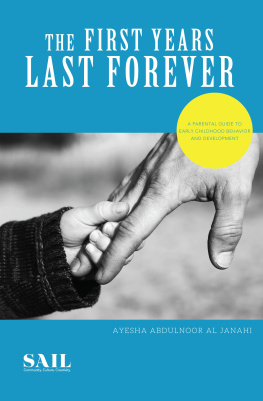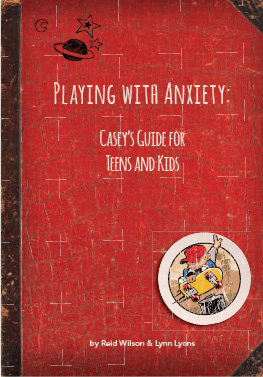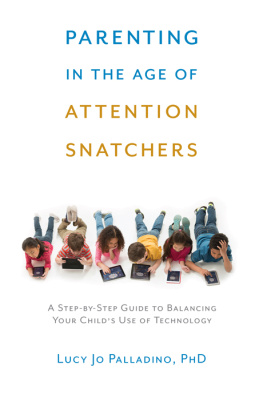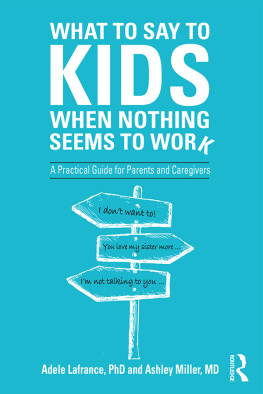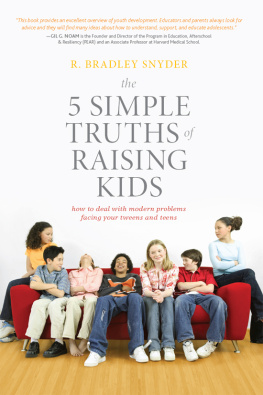

FIRESIDE
Rockefeller Center
1230 Avenue of the
Americas New York, NY 10020
www.SimonandSchuster.com
Copyright 1998 by Audrey Ricker, Ph.D. and Carolyn Crowder, Ph.D.
All rights reserved,
including the right of reproduction
in whole or in part in any form.
FIRESIDE and colophon are registered trademarks
of Simon & Schuster Inc.
Designed by Jennifer Ann Daddio
Manufactured in the United States of America
11 13 15 17 19 20 18 16 14 12
Library of Congress Cataloging-in-Publication Data
Ricker, Audrey.
Backtalk: four steps to ending rude behavior in your kids / Audrey Ricker and
Carolyn Crowder.
p. cm.
A Fireside book.
Includes index.
1. Child rearing. 2. Parent and child. 3. Discipline of children. 4. Children
Conduct of life. 5. Respect. Crowder, Carolyn Zoe. II. Title.
HQ769.R52 1998
649.64-dc21 97-36549
CIP
ISBN 0-684-84124-X
ISBN-13: 978-0-6848-4124-3
eISBN-13: 9781439147764
To Henrietta Terrazas-Dyer; a model mother, and to Ana, Alex, and Carlos Terrazas, her model children
A.R
To Dr. Oscar Christensen, who has taught so many about respectful relationships with children
C.C.
CONTENTS
AUTHORS NOTE
When I began studying psychology, the theory of behavior that made the most sense to me was one developed by Alfred Adler. Although he wrote at the turn of the century, Adlers philosophy is surprisingly pertinent to modern-day problems. Adlerian psychology provides the basis for this book. If you dont understand this theory as you begin to read, come back to it when you finish. The following information will be more understandable to you at that time.
Adlerand later, his disciple, Rudolf Dreikurs believed the most important point to make to parents was that their reaction to a childs misbehavior would either (1) encourage the behavior, resulting in its recurrence, or (2) discourage the behavior. In other words, a parents response makes all the difference.
Adler felt that children misbehave in order to find significance in the family. A child who cannot find a sense of belonging through positive behavior will choose negative actions. By belonging in a positive sense, I do not mean the child is made the center of attention. Belonging positively includes cooperating with, contributing to, and having empathy for others. When children backtalk and get a reaction from their parents such as You cant talk to me that way or You better watch it or Ill, they learn that backtalk brings them attention, power, and often a way of hurting their parents.
This ability to get attention, albeit negative, to dominate, or to get back at parental figures makes the child feel significant. But this is a negative significance and we want our children to feel positive significance. We make a big difference by the way we respond to their misbehavior.
This book provides a way for you to respond to backtalk that will allow children to find ways to belong positively, not just in the family but everywhere else as well.
Our four-step system is an example of the Adlerian idea of logical consequences put into practice. A logical consequence is just thata consequence that is a result of the misbehavior. It is not punishment because it is not arbitrary, and it never involves screaming, threatening, spanking, sarcasm, or lecturing. When parents consistently follow through with logical consequences, children learn that parents mean what they say and will follow through.
As an Adlerian, I feel I ought to stress the need to provide ways for our children to find positive significance, especially through making a real contribution to the family as a whole. Simple actionshelping to prepare a meal or plan a vacation and pitching in when a parent or sibling is sickbuild feelings of significance and empathy. So, as you find yourself responding constructively to backtalk, think of ways to involve your children in contributing to others.
C.C.
INTRODUCTION
If you picked up this book, chances are you are having trouble with backtalk from your children. Youve probably been told that you shouldnt pay attention to it, that its just the way children express themselves these days.
But our position is that you should do something about it. Your children need you to do something about it. With this book as your guide, you will learn a pattern of responding that will enable you to deal with backtalk immediately, every time it happens. When children are allowed to get away with backtalk, they dont learn to have respect for others.
Dr. Ricker wanted to write this book because she saw that her students backtalk was completely out of hand, whether they were in elementary school or college. As a mother she had to deal with backtalk. She saw that firm consequences not only eliminated the backtalk problem but also helped the child.
Dr. Crowder, a psychologist and parent trainer, has long wanted to provide a theoretical and behavioral framework for handling this problem. In her parenting classes she has observed that nearly all parents are confused about, and feel helpless in, handling their childrens backtalk.
This book is aimed at preventing backtalk. Parents, teachers, and other adults who deal with children will find that the book provides a clear, simple method of responding to the problem. This response consists of a Four-Step Program that anyone can use, with consistent practice.
Here is a scenario that shows how backtalk can strike for the first time when it is least expected.
Case History #1: The Jones family was gathered in the living room watching television and reading while Mary Jones grilled hamburgers for dinner. Mary and John Jones are both physicians, the eleven-year-old twin boys are soccer players, and sixteen-year-old Joe is an honor student and track star. The rapport that Mary and John enjoy with their children is the envy of all their friends.
On this particular night Mrs. Jones came in to ask how everyone wanted his hamburger cooked, medium or well done?
Medium, said one twin.
Same, said the other.
Medium well, said John.
Joe? asked Mary. What about you?
Silence. Joe did not even turn and look at her.
Joe? How about your burger? Mary prompted cheerfully.
Im watching this show Joe said, his tone full of annoyance. Cant you see that? God! He then turned his attention back to the television, ignoring his mother completely.
Joes response to his mother included the following characteristics: sudden rudeness, nasty tone, inflected syllables, hostility, and bullying control of the conversation. In other words, Joe started the backtalk attack without provocation, he controlled the nature of the attack, and he ended it when he decided to. Mary never knew what hit her!
At this point, parents like Mary and John typically see only two possible responses either to ignore the attack or to escalate the negative exchange, neither of which will help to solve the problem. In doing nothing constructive, the parents are left wondering where they went wrong and the twins are being influenced by their older brothers rude behavior.
However, there is another way to handle the situation. The parents in this example could use the steps weve outlined in this book to stop this backtalk and future attacks. It pays to be prepared to deal with backtalk before it happens. If youve already experienced it in your household, its not too late to manage it successfully. The fact is, rude behavior
Next page

